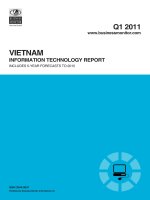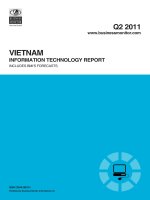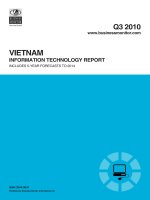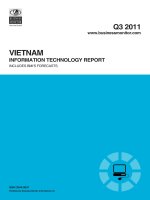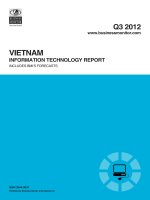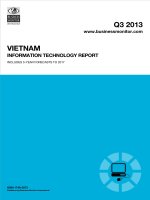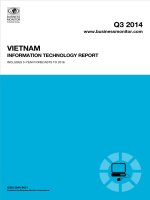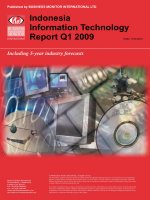Indonesia information technology report q3 2011
Bạn đang xem bản rút gọn của tài liệu. Xem và tải ngay bản đầy đủ của tài liệu tại đây (482.74 KB, 58 trang )
Q3 2011
Published by Business Monitor International Ltd.
www.businessmonitor.com
INFORMATION TECHNOLOGY REPORT
ISSN 1750-5070
Published by Business Monitor International Ltd.
INDONESIA
INCLUDES BMI'S FORECASTS
Business Monitor International
85 Queen Victoria Street
London, EC4V 4AB
UK
Tel: +44 (0) 20 7248 0468
Fax: +44 (0) 20 7248 0467
Email:
Web:
© 2011 Business Monitor International.
All rights reserved.
All information contained in this publication is
copyrighted in the name of Business Monitor
International, and as such no part of this publication
may be reproduced, repackaged, redistributed, resold in
whole or in any part, or used in any form or by any
means graphic, electronic or mechanical, including
photocopying, recording, taping, or by information
storage or retrieval, or by any other means, without the
express written consent of the publisher.
DISCLAIMER
All information contained in this publication has been researched and compiled from sources believed to be accurate and reliable at the time of
publishing. However, in view of the natural scope for human and/or mechanical error, either at source or during production, Business Monitor
International accepts no liability whatsoever for any loss or damage resulting from errors, inaccuracies or omissions affecting any part of the
publication. All information is provided without warranty, and Business Monitor International makes no representation of warranty of any kind as
to the accuracy or completeness of any information hereto contained.
INDONESIA INFORMATION
TECHNOLOGY REPORT
Q3 2011
INCLUDES 5-YEAR FORECASTS TO 2015
Part of BMI’s Industry Report & Forecasts Series
Published by: Business Monitor International
Copy deadline: July 2011
Indonesia Information Technology Report Q3 2011
© Business Monitor International Ltd Page 2
Indonesia Information Technology Report Q3 2011
© Business Monitor International Ltd Page 3
CONTENTS
Executive Summary 5
SWOT Analysis 8
Indonesia IT SWOT 8
Indonesia Telecoms SWOT 9
Indonesia Political SWOT 10
Indonesia Economic SWOT 11
Indonesia Business Environment SWOT 12
IT Business Environment Ratings 13
Asia 13
Table: Regional IT Business Environment Ratings 13
Asia IT Markets Overview 17
IT Penetration 17
Sectors And Verticals 20
Indonesia Market Overview 24
Table: Key Ministers And Departments 24
Background 25
Hardware 26
Software 28
Services 30
Industry Developments 32
Industry Forecast Scenario 35
Table: Indonesian IT Industry, 2006-2015 (US$mn Unless Otherwise Stated) 37
Country Context 38
Table: Consumer Expenditure, 2000-2010 (US$) 38
Table: Rural & Urban Breakdown, 2005-2030 38
Internet 39
Table: Telecoms Sector Internet Historical Data And Forecasts 39
Macroeconomic Forecast 41
Table: Indonesia – Economic Activity 43
Competitive Landscape 44
Hardware 44
Software 46
IT Services 47
Internet Competitive Landscape 48
Company Profiles 49
IBM Indonesia 49
Oracle 50
Sigma 51
HP 52
BMI Methodology 53
How We Generate Our Industry Forecasts 53
Indonesia Information Technology Report Q3 2011
© Business Monitor International Ltd Page 4
IT Industry 53
IT Ratings – Methodology 54
Table: IT Business Environment Indicators 55
Weighting 56
Table: Weighting Of Components 56
Sources 56
Indonesia Information Technology Report Q3 2011
© Business Monitor International Ltd Page 5
Executive Summary
The Indonesian IT market is forecast to grow at a compound annual growth rate (CAGR) of 18% over the
2011-2015 period. with a revival in business spending building on momentum from consumer spending.
In 2010, computers sales grew strongly, and double-digit growth is expected again in 2011.
Indonesia is forecast to be one of the best regional IT market growth prospects over BMI's five-year
forecast period. IT spending is forecast to increase to US$5.4bn in 2011, up from US$4.7bn in 2010.
Some fundamental drivers, including rising computer penetration and growing affordability, should
ensure that the market remains firmly in positive growth territory. Growing investment in datacentres and
other ICT infrastructure will support more demand for outsourcing and cloud computing.
By 2015, IT spending is projected to reach a value of US$10.2bn. With information and communication
technology (ICT) penetration of around just 20% and development restricted to richer areas such as Java,
the market has much growth potential. However, the country's uneven development and digital divide are
major barriers to faster growth in this potentially huge IT market.
Industry Developments
In 2010, Indonesia's information society development received a boost when the government said that it
would start to introduce e-passports. Indonesia will thus follow in the footsteps of other South East Asian
countries such as Singapore, Malaysia and Thailand. The immigration department plans to distribute
10,000 e-passports in the first phase, with these being mainly available in immigration offices in Jakarta,
Semarang and Surabaya.
The government is also rolling out e-learning initiatives, which could cause education's share of local IT
spending to rise from its estimated level of around 4%. The ratio of PCs to students in public schools is
around 1:3,200. The government wants to increase this to 1:20. As there are 53mn students in the
Indonesian schools system, this would require at least 2.5mn computers.
Competitive Landscape
In May 2011, Lenovo, the bestselling computer vendor in the Asian region, announced plans to achieve a
double-digit Indonesia PC market share in its current fiscal year. According to company data, the
company currently has a share of around 7.6%. The consumer segment is the one that Lenovo has
targeted for most growth in 2011, building on moves last year to create a stronger logistics and service
infrastructure in Indonesia.
In the enterprise applications segment, leading global vendor SAP has said it was optimistic that it could
maintain its recent 60% annual growth momentum in Indonesia. Meanwhile, US rival Oracle is also
Indonesia Information Technology Report Q3 2011
© Business Monitor International Ltd Page 6
active in the Indonesian market, with new clients in H111 including Acuatico Air Indonesia, one of the
main players in water distribution in the South East Asian region.
Cloud computing will be a key focus for vendors in 2011. In 2010, Telkom partnered with Microsoft to
launch cloud computing services, including platform-as-a-service (PaaS), infrastructure-as-a-service
(IaaS) and software-as-a-service (SaaS). Meanwhile in March 2011, InstaCompute, a subsidiary of Indian
IT giant Tata Communications, launched cloud computing services in Indonesia.
Hardware
BMI forecasts 2011 Indonesian computer hardware spending of US$3.9bn, up from US$3.2bn in 2010.
The market is forecast to rise to a value of US$7.1bn by 2015. In 2010, consumer demand was reinforced
by a revival in business IT hardware spending, which could account for about two-thirds of sales
opportunities during the forecast period, with sales value doubling by 2015.
Hardware accounts for more than 70% of Indonesian IT spending. The main drivers are growing
affordability and more credit availability in a country where only about 20% of the population have
access to a PC, compared with more than 40% in some other South East Asian countries such as Malaysia
or Thailand.
Software
Indonesia's software sales are forecast by BMI to reach US$599mn in 2011, up from an estimated
US$535mn in 2010. During BMI's five-year forecast period to 2015, the software sector CAGR is
forecast at 22%. In 2011, migrations to Microsoft's new Windows 7 operating system should remain a
driver, although much will depend on consumer and business confidence. One market inhibitor is the
continuing software piracy problem, which, according to the government's own figures, loses Indonesian
software companies more than US$100mn per year.
Over the forecast period, enterprise resource planning (ERP) software should continue to be of most
interest to small- and medium-sized enterprises (SMEs) as only around 20% of Indonesian SMEs are
estimated to make use of IT. In addition to cost savings, businesses will look to boost efficiency
and increase the flexibility of responses to customer needs.
IT Services
Indonesia's IT services market is forecast to be worth US$880mn in 2011, recording double-digit growth
from US$769mn in 2010, based on BMI estimates. IT services account for 17% of Indonesia's hardware-
centric IT market sales. Hardware deployment services remain the largest Indonesian IT services category
with a 20% market share.
Indonesia Information Technology Report Q3 2011
© Business Monitor International Ltd Page 7
Improvements in Indonesia's telecoms and ICT infrastructure are expected to drive long-term growth in
the Indonesian IT services market. Commercial datacentres are being built, linked to growing rollout by
public sector and commercial organisations of e-government or e-commerce services. However, most
opportunities are in fundamental service areas such as system integration, support systems, training,
professional services, outsourcing and internet services.
E-Readiness
Low telephone line density, high charges and low PC penetration are all significant obstacles to higher
internet penetration. However, the situation is not all bad, with signs of faster growth in user numbers and
recent surveys showing that, among a very small elite, there is fast adoption (by regional standards) of
broadband and a willingness to pay for video conferencing, security and other additional features. The
government is encouraging fixed wireless deployments, including WiMAX, to bring the internet to more
remote areas.
The government is also rolling out an internet-based National Education Network, which involves 1,000
network points in five clusters nationwide, designed to facilitate the use of the internet in schools. Despite
some advances in e-education, constraints remain due to poor infrastructure and a lack of public
awareness in a country where only 20mn people own fixed-line telephones.
Indonesia Information Technology Report Q3 2011
© Business Monitor International Ltd Page 8
SWOT Analysis
Indonesia IT SWOT
Strengths
Large potential market.
The market may be entering a faster growth stage. It is forecast to grow quicker than
most other Association of South East Asian Nations (ASEAN) markets over the
forecast period to 2014 due to its underdeveloped nature.
Weaknesses
Computer penetration is among the lowest in South East Asia, estimated at only 1.5%.
Underdeveloped telecommunications infrastructure due to years of government
control and slow progress in deregulation.
Lack of government support, and there is still no unified ICT ministry.
History of recent political instability.
Legal concerns, such as intellectual property rights, are a deterrent to foreign direct
investment.
Opportunities
Some positive trends: computer ownership and internet access are on the rise, and
the government is showing signs of taking intellectual property more seriously.
Per capita IT spending to increase by 50% over 2010-2014.
Opportunities exist in services such as system integration, support systems, training,
professional services, outsourcing and internet services.
Computer sales are predicted to grow faster than almost anywhere else in the ASEAN
over the next few years, although from a lower base.
Threats
Continuing lack of government action to support increased PC penetration and
internet access, or drive ICT sector development.
The global economic slowdown may hit key demand segments.
Indonesia Information Technology Report Q3 2011
© Business Monitor International Ltd Page 9
Indonesia Telecoms SWOT
Strengths
A rapidly growing mobile sector due to the emergence of greater competition.
The presence of key strategic investors, including SingTel, ST Telemedia of
Singapore, Telekom Malaysia, Maxis of Malaysia, Hong Kong's Hutchison and the
UAE's Etisalat.
Weaknesses
Security and corruption issues still make Indonesia a risky investment climate.
Limited mobile spectrum due to overcrowding in the sector following the government
decision to open the market to greater competition.
Mobile broadband spectrum fees remain high for operators, reducing the
implementation and variety of tariffs.
Operators struggling with raised costs after the government forced companies to
charge a fee based on cost rather than share part of their revenues.
Opportunities
The mobile market expected to surge over the coming years, reaching nearly 431mn
people over the forecast period.
The popularity of mobile value-added/data services offers potential to international
content providers.
The growth of 3G will lead to investment opportunities for content providers and
distributors.
Threats
A government registration scheme could lead to short-term fall in fixed wireless and
mobile users as non-registrants are deactivated.
The dominance of the prepaid market leading to falling average revenue per user
rates.
Mobile operators could put too much emphasis on 3G mobile network expansion
when consumer demand is unproven at the expense of 2G growth.
Indonesia Information Technology Report Q3 2011
© Business Monitor International Ltd Page 10
Indonesia Political SWOT
Strengths
Indonesia managed a successful transition to democracy in 2004. In addition, the
2009 parliamentary and presidential elections passed by peacefully, signalling the
consolidation of the democratic process.
The military's role in politics has gradually been reduced. The prospects of a military
coup – which seemed a real possibility in the late 1990s and early 2000s – have
diminished substantially.
Weaknesses
Indonesia's domestic political scene is characterised by a proliferation of minority
parties, and formal and informal coalitions are necessary to govern and legislate.
Moreover, the efficiency of state institutions is encumbered by bureaucracy and
corruption.
Indonesia's cultural and ethnic diversity saw the archipelago wracked by separatist
rebellion and ethnic violence in the late 1990s and early 2000s, which took great
efforts to bring to heel. In the event of a new economic crisis, calls for regional
secession could re-emerge.
Opportunities
President Susilo Bambang Yudhoyono's Democratic Party had a strong showing in
the 2009 parliamentary elections. Coupled with a strong mandate following his re-
election in the same year, the implementation of policies in the legislature should
potentially become less problematic.
Indonesia's status as the world's most populous Muslim country leaves it well
positioned to speak out on global Islamic issues, and act as a bridge between the
Middle East and the Asia Pacific region.
Threats
Regional militant group Jemaah Islamiah (JI) poses a lingering threat to security in
Indonesia. JI is blamed for a series of attacks, including the Bali bombings of October
2002 and other such incidents, including the Jakarta bombings of July 2009.
The fact that Indonesia subsidises basic goods means that, when the government
raises prices, there is a risk of public unrest, or at least a political backlash.
Indonesia Information Technology Report Q3 2011
© Business Monitor International Ltd Page 11
Indonesia Economic SWOT
Strengths
Indonesia's strategic location between the Indian and Pacific Oceans and its
adjacency to major East-West trade routes make it an important economy in the
region.
Indonesia has a low cost and large supply of available labour resources.
Weaknesses
Indonesia's economy is not growing fast enough to reduce joblessness. Although
unemployment has been decreasing, the unemployment rate is still relatively high, at
7.1% in February 2010. Many are forced to work in the informal sector.
Indonesia's physical infrastructure is considered substandard. The archipelagic nature
of the country makes it difficult to weave national infrastructure together.
Opportunities
Indonesia could attract much-needed foreign investment by strengthening its business
environment, particularly through reform of its unreliable legal system.
Indonesia stands to benefit from the rise of Islamic financing, having adopted new
legislation in early 2008 designed to tap into this rapidly expanding sphere.
Threats
Production at Indonesia's ageing oil fields has been in decline since the mid-1990s.
Thus, the country has become a net importer of crude oil in recent years, adding
downward pressure on its current account position. But the resumption of the Cepu
field in late 2009 may change this.
Indonesia is perceived as one of Asia's riskier destinations. This leaves the economy
vulnerable to sudden capital outflows at times of risk aversion, which can lead to
sharp swings in the currency.
Indonesia Information Technology Report Q3 2011
© Business Monitor International Ltd Page 12
Indonesia Business Environment SWOT
Strengths
Indonesia is South East Asia's largest economy with a nominal GDP of US$500bn and
is the world's fourth-most populous country with almost 240mn people. It thus offers
investors a vast home market in which to do business.
Indonesia is also a founding member of the Association of South East Asian Nations
(ASEAN). As a member of ASEAN's Free Trade Area (AFTA), Indonesia is committed
to lowering tariff and non-tariff barriers to trade.
Weaknesses
Corruption remains a major problem. Indonesia ranked 110th out of 180 countries
surveyed in Transparency International's 2010 Corruption Perceptions Index, where a
low ranking denotes a higher degree of corruption.
Indonesia's excessive bureaucracy makes it a difficult place to do business. Among
Asian economies, Indonesia has the longest period to start a business. Labour laws
are also considered excessive.
Opportunities
The Yudhoyono administration has gradually been reforming the business
environment, particularly by strengthening the legal system and fighting corruption. If
sustained, this would boost investor interest in Indonesia.
Indonesia has been amending its debt and banking regulations, with the aim of
attracting Islamic financial activities.
Threats
Recent high-level business disputes between the government and foreign investors
demonstrate that, even after investments become up-and-running, there is still scope
for legal problems or obstacles posed by legal wrangling.
Security threats are a concern for investors. Despite several of its top leaders having
been arrested in recent years, JI, the radical Islamist militant group blamed for the Bali
bombings, remains active. There is also a low-level threat from separatist rebels or
from intercommunal tensions.
Indonesia Information Technology Report Q3 2011
© Business Monitor International Ltd Page 13
IT Business Environment Ratings
Asia
Table: Regional IT Business Environment Ratings
Limits Of Potential
Return
Risks To Realisation
Of Returns
IT Market
Country
Structure
Limits
Market
Risks
Country
Risk
Risks
IT BE
Rating
Regional
Ranking
Australia 56
100
71
80
71
75
72.2
1
Singapore 53
100
69
70
85
79
72.1
2
Hong Kong 48
95
65
70
87
80
69.4
3
South Korea 52
75
60
75
71
73
63.9
4
Malaysia 41
50
44
35
77
60
49.1
5
China 52
35
46
35
68
55
48.7
6
Vietnam 36
60
44
35
44
41
43.1
7
Philippines 37
45
40
43
52
48
42.2
8
India 49
15
37
45
56
51
41.4
9
Thailand 40
20
33
35
73
58
40.4
10
Indonesia 38
35
37
35
52
45
39.1
11
Sri Lanka 30
10
23
35
44
41
28.3
12
Scores out of 100, with 100 highest. The IT BE Rating is the principal rating. It comprises two sub-ratings, 'Limits Of
Potential Returns' and 'Risks To Realisation Of Returns', which have a 70% and 30% weighting respectively. In turn,
the 'Limits' rating comprises Market and Country Structure, which have a 70% and 30% weighting respectively and are
based upon growth/size/maturity/govt policy of IT industry (Market) and the broader economic/socio-demographic
environment (Country). The 'Risks' rating comprises Market Risks and Country Risk, which have a 40% and 60%
weighting respectively and are based on a subjective evaluation of industry regulatory and IP regulations (Market) and
the industry's broader Country Risk exposure (Country), which is based on BMI's proprietary Country Risk ratings. The
ratings structure is aligned across the 14 industries for which BMI provides Business Environment Ratings
methodology and is designed to enable clients to consider each rating individually or as a composite, which the choice
depending on their exposure to the industry in each particular state. For a list of the data/indicators used, please
consult the appendix at the back of the report. Source: BMI
BMI's Asia IT Business Environment Ratings (BER) compare the potential of a selection of the region's
markets over our forecast period through to 2015. Our Q311 ratings reflect our consideration of the
political and economic risks, as well as risks associated specifically with IT intellectual property (IP)
rights protection and the implementation of state spending projects.
Indonesia Information Technology Report Q3 2011
© Business Monitor International Ltd Page 14
There are no changes in country rankings in our updated Asia Q311 BER ratings. Across the Asia Pacific
region in 2010, global economic recovery and improved consumer confidence resulted in improved
trading conditions for IT vendors, and a stronger than expected rebound in PC sales.
Australia therefore retains its top regional rating this quarter. One area of opportunity in 2011 is growing
demand for cloud computing services. A wide range of leading Australian private and public sector
organisations have launched cloud initiatives, including many of the country's leading banks. Meanwhile,
the government has unveiled a six-year cloud computing strategy.
IT verticals such as government, telecoms, healthcare and banking should continue to supply demand for
implementation, consulting and managed services in future. The government's commitment to continue to
implement the National Broadband Network project will drive the development of Australia's digital
economy and feed demand for PCs.
The smaller, but mature IT markets of Singapore and Hong Kong take second and third positions
respectively in our ratings table, due primarily to their high Country Structure scores. Hong Kong and
Singapore are expected to emerge as cloud computing hubs due to growing interest in cloud computing
across the region.
Key sectors of the Hong Kong economy such as financial services are investing in modernisation as Hong
Kong strives to maintain its regional hub status in the face of competition from rivals such as Shanghai.
Hong Kong also continues to offer IT investors opportunities associated with its growing links to the vast
Chinese market.
Singapore benefits from high broadband penetration and initiatives such as the government's ambitious
Intelligent Nation 2015 plan, and the standard operating environment. Spending on IT services will be
boosted by the continuing boom in IT-enabled services such as call centres and back-office financial
services. Other promising sectors for IT services include healthcare, as the government launches a series
of initiatives to develop health technology.
On the downside, the continued restructuring of both economies, towards a more service-oriented model,
may limit long-term growth prospects. However, this also brings opportunities in sectors such as financial
services and banking. Businesses will probably remain cautious and value-focused over the short term.
BMI forecasts that South Koreans will increasingly choose to spend money on IT products due to a
substantial increase in disposable incomes. Consumers appear willing to upgrade their PCs, and there is
also a trend for households to own more than one computer.
Indonesia Information Technology Report Q3 2011
© Business Monitor International Ltd Page 15
Meanwhile, South Korea's government is encouraging the utilisation of cloud computing by small
businesses. New cloud computing offerings and increased competition in this segment are expected to
fuel growing demand to utilise this technology. IT outsourcing is also expected to show a strong demand
trajectory.
Malaysia remains in fifth position in our Q311 regional ratings. IT spending growth will be driven by the
government's drive for greater broadband penetration. It has set an optimistic target of 75% by 2015. The
rollout of a high-speed broadband network will boost IT spending outside the Klang Valley. Other
projected growth and PC market drivers include a rise in the PC penetration level from about 35%, tax
exemptions for notebooks and growth in disposable incomes.
There are increasingly attractive opportunities in the IT services area as the government implements
measures to make Malaysia a growing regional services and outsourcing hub. Cloud computing will also
be a growth area and the government has named cloud computing as one of its top 10 strategic technology
priorities.
In China, factors such as the vast potential rural market and a commitment to modernisation in sectors
such as education, healthcare and manufacturing will help sustain market growth. Over the forecast
period, government spending, an expansion of consumer credit and expectations about China's long-term
economic growth will also drive IT investments.
In the Chinese IT services segment, growing interest in cloud computing will be stimulated by the
establishment of government pilot programmes in five cities. However, there are still market risks
associated with IP rights protection in China, as well as piracy and a lack of business transparency.
Pressure on hardware prices is also a risk in the current environment.
Vietnamese IT demand, although with a rather smaller market than its leading neighbor to the north, is
expected to have several long-term drivers. Vietnam's improving ICT infrastructure will facilitate the
development of the nation's IT market in a country with just 15% PC penetration.
Vietnamese government digital divide programmes to boost internet and digital utility in rural areas will
help addressable market growth and open PC ownership to a growing number of rural inhabitants.
Vietnam's gradual integration into global trade networks such as ASEAN and the WTO has helped reduce
tariff barriers and prices, and has increased opportunities.
In the Philippines, the IT market will be driven by the local IT and business process outsourcing (BPO)
sector. The BPO industry, which accounts for around 30% of IT spending, continues to grow. The
Philippines has a lower PC penetration than many other Asian countries and the IT market offers
corresponding high growth potential over the forecast period.
Indonesia Information Technology Report Q3 2011
© Business Monitor International Ltd Page 16
However, the Philippines faces challenges such as labour shortages and rising wages. In the enterprise
segment, surveys suggest that many enterprises including small and medium-sized enterprises (SMEs)
plan to increase IT spending again in 2011.
India also recorded impressive double-digit year-on-year (y-o-y) computer sales growth in 2010. The
potential is clear, with less than 2% of the population owning a computer, which is about 20% of the level
in China. It was estimated that 5% of India's 7.5mn SMEs could implement a technology solution in
2010. Significant opportunities will be created by demand from Indian businesses and government
agencies for help to utilise cloud computing.
Realisation of India's growth potential depends on fundamental drivers such as increasing India's low
computer penetration, rising incomes, falling computer prices and the government's ambitions to connect
the country's vast rural areas to the rest of the world.
The last three markets in our regional ratings have low scores due primarily to business environment
factors, despite considerable growth potential. In Thailand, the fundamentals of growing affordability and
low PC penetration should keep the market in positive territory during the forecast period. A number of
factors should also support momentum, including the government's PC for Education programme and 3G
mobile and WiMAX broadband service rollouts.
Similarly, with ICT penetration of only about 20% and development restricted to richer areas such as
Java, the Indonesian IT market has much growth potential. BMI expects the Indonesian market to be one
of the fastest growing in the region over the five-year forecast period. The SME sector will drive demand
for basic hardware and applications as enterprises focus on enhanced productivity.
Sri Lanka's IT market has benefited from the restoration of peace and improvements in the security
situation, which helped release pent-up demand for IT solutions. The country has felt the effects of
instability over the years, from disruption of distribution channels and a flourishing grey market to the
underdeveloped telecoms infrastructure. However, the Sri Lanka will feature on IT vendors' radars as one
of the best potential growth prospects in South Asia. Computerisation has only started in government
services. Major public and private sector organisations remain largely underpenetrated in terms of basic
enterprise software.
Indonesia Information Technology Report Q3 2011
© Business Monitor International Ltd Page 17
Asia IT Markets Overview
IT Penetration
Across Asia, government ICT initiatives and
growing affordability will help to drive increases
in PC penetration during BMI's five-year forecast
period. While some cities and regions stand out,
there is an unbalanced pattern of regional
development, with PC penetration in countries
such as Singapore above 50%, while in other
countries, such as Indonesia, it is below 5%.
The two Asian leaders, China and India, embody
the region's growth potential, as in both countries
computer ownership remains the preserve of a
minority. In China, PC penetration was only
around 25% in 2010 - although it was far higher in
cities such as Shanghai and Beijing and urban PC penetration is projected to pass 60% by 2015. In India,
less than 5% of people own a computer. However, some 45% of the population is under 25, which
provides a promising demographic context for increased PC ownership. PC penetration in Vietnam was
estimated by BMI at around 15% in 2010. Notebooks are owned by an estimated 7% of the Vietnamese
population, which points to significant growth
potential for the local PC market.
Lower prices will help to drive higher PC
penetration in developing markets. The average
price of a PC in the Indian market has nearly
halved over the past few years, and rising incomes
and greater credit availability will continue to
bring computers within the reach of lower-income
demographics. Even in more mature markets, there
is room for development, however, with official
data suggesting that as many as 25% of Hong
Kong households do not have a computer at home.
Around the region, affordable computer
programmes continue to find favour with
governments. In China, a subsidised household electronics products initiative aimed at rural residents has
Narrowband Penetration
Per 100 Population
e/f = estimate/forecast. Source: BMI
Broadband Penetration
Per 100 Population
e/f = estimate/forecast. Source: BMI
Indonesia Information Technology Report Q3 2011
© Business Monitor International Ltd Page 18
helped to boost PC sales in areas where penetration was low. In Australia in 2010, national and state
governments continued to roll out new initiatives, with the Victoria government investing more than
US$150mn in IT in schools.
In Indonesia, PC penetration of around 2% could double by 2013 if government initiatives are followed
through. The Indonesian government is also rolling out new e-learning initiatives, with a target of raising
the current 1:3,200 ratio of PCs to students in public schools to 1:20. Meanwhile, in 2010, the Vietnamese
government launched a programme entitled One Teacher-One Computer, which offered discounts on PCs
for teachers and students.
A similarly broad range is found with respect to internet penetration. The highest levels of internet
penetration are found in Singapore, South Korea, Hong Kong and Australia, with estimated 2011
penetration rates of 78.5%, 76.4% and 75.5% and 67.4% respectively. Singapore has by far the highest
rate of broadband penetration, which was estimated at 160.2% in 2011. Meanwhile, the Philippines has
the one of lowest levels of internet usage, with just 7.1% narrowband and 6.1% broadband penetration
estimated in 2011.
The fastest growth is expected in Indonesia, where internet penetration is projected to leap from 36% in
2011 to 67.4% by 2015. India is now at above 28% internet penetration despite a lack of fixed-line
infrastructure, and this should reach 36% by 2015. Steady growth is also projected for Sri Lanka, where
penetration is projected to increase from 14.1% to 19.4% by 2015. Some 60.4% of Malaysians had
internet access in 2010.
Dial-up technology is still the dominant access method in many states. However, even in developing
markets, the number of broadband subscribers continues to gain ground steadily. Broadband penetration
has been boosted by growing numbers of mobile broadband users, as 3G mobile services are expanded
across the region. In China, broadband penetration is on course to reach 33.1% by 2015. In India,
penetration should increase sixfold to reach 9.4% by 2015 from around 1.5% currently, although this
remains below government targets. Singapore will also see continued strong growth in broadband
penetration, which is projected to reach 186% by 2015.
Across the region, government programmes are an important driver of ICT penetration. The Chinese
government has a five-year plan to make the internet available in every administrative village in central
and eastern China and every township in the west. In Australia, the government's commitment to develop
the National Broadband Network should further the development of Australia's digital economy.
Meanwhile, the growth of Wi-Fi coverage will be one driver of notebook sales in places such as Hong
Kong, where the government has committed another HKD200mn to the deployment of a Wi-Fi network
covering more than 200 public venues.
Indonesia Information Technology Report Q3 2011
© Business Monitor International Ltd Page 19
IT Growth and Drivers
Across the region in 2011, IT spending should
benefit from improved economic circumstances
and tenders, previously deferred as a result of the
economic situation, although much will depend on
business confidence. Strong fundamental demand
drivers of IT spending mean that there will be
continued opportunities. Key factors common to
most markets include cheaper PCs and reform in
sectors such as telecommunications and finance,
as well as government initiatives.
In some of the region's largest markets, such as
China, lower-tier cities and towns will be among
the fastest growing segment of the IT market. BMI expects China's IT market growth to be driven by an
expansion into western China and rural areas well as growing demand from small and medium-sized
enterprises (SMEs). The Chinese IT market will also receive a boost in 2011 from a 50% increase in
import tariffs on some electronics products, such
as laptops.
In Thailand in 2011, demand will be bolstered by
market expansion in the relatively underpenetrated
rural areas. SIS forecasts that market growth in
upcountry areas will be 30% in 2011, double that
forecast for the country as a whole. A similar
situation pertains to India where in 2011 there are
expected to be strong growth opportunities in
smaller cities.
The long-term potential of India's IT market is
plain: less than 3% of people in India own a
computer (about one-fifth of the level in China),
meaning particular potential in the lower-end product range. India's IT market appears to be positioned
for strong growth thanks to an improving economy and consumer sentiment, and government support for
modernisation in lagging sectors. Meanwhile, India's business process outsourcing industry is growing at
around 40% per annum and will continue to generate opportunities for vendors of IT products and
services.
2011e IT Market Sizes
US$mn
e = estimate. Source: BMI
IT Market Sizes
As % Of National GDPs
e/f = estimate/forecast. Source: BMI
Indonesia Information Technology Report Q3 2011
© Business Monitor International Ltd Page 20
The Philippines is one of the countries currently
benefiting from low-priced PC programmes
(PC4ALL), which provide opportunities for
vendors to penetrate the low-income segments.
Other regional computer sale drivers over the
forecast period include education, lower prices, IP
telephony, cheaper processors as well as notebook
entertainment and wireless networking features.
Meanwhile, in Indonesia, the basic demographics
of rising computer penetration and growing
affordability should drive growth. SMEs represent
a growth opportunity, as currently only around
20% of Indonesian SMEs are estimated to make
use of IT. Compliance with government and
international regulations will be a driver in financial, manufacturing and other sectors.
In more developed markets, such as Hong Kong and Singapore, robust retail sales led the way in early
2010 as spending recorded positive growth following a contraction in 2009. In Hong Kong consumer
spending is expected to remain strong in 2010, as evidenced by the positive early reception for Apple's
iPad. IT market growth will be driven by government IT spending as well as cross-border trade and
cooperation.
The largest IT market in the region is, unsurprisingly, China, estimated at US$105.4bn in 2011, trailed
distantly by Australia (US$20.8bn), India (US$19.7bn) and South Korea (US$17.8bn.) Singapore's IT
market (including communications) is the largest as a proportion of national GDP (2.2%), followed by
Hong Kong (2.1%). Thailand's IT market was affected last year by a number of exogenous events
including floods in the north east of the country, and political unrest. However, in 2011 the country looks
to be back on track.
The fastest growing IT markets over the forecast period are projected to be India and Indonesia with
2011-2015 compound growth of 109% and 91% respectively, driven by increasing PC penetration. Sri
Lanka is third with the IT market growing by an estimated 89% over BMI's five-year forecast period,
while China's total growth is estimated at a still healthy 70%.
Sectors And Verticals
Regional IT markets remain hardware-centric, with hardware accounting for 25-74% of total spending in
all markets in 2010. However, spending on software and services will grow faster. Notebook sales are
growing much faster than the PC market as a whole with growth driven by falling prices and more
features.
IT Markets
Compound Growth
2011e-2015f (%)
e/f = estimate/forecast. Source: BMI
Indonesia Information Technology Report Q3 2011
© Business Monitor International Ltd Page 21
In mature markets such as Australia and Singapore, PC sales are dominated by replacement sales. In
Australia, upgrades are estimated to account for at least 80% of business purchases and more than 50% in
the case of households. More than 90% of Australian households now have a PC, but consumers have
appeared willing to spend on upgrading their notebook computers and it is also becoming more popular to
purchase a second household PC. Indeed, around 30% of households have more than one PC.
Tablet sales will lead to a new PC market growth area, with triple-digit growth projected in many
markets. In China it is estimated that tablets could account for around 6-7% of computer sales in 2011.
However, partly thanks to the tablets surge, demand for netbooks has lost momentum in some markets.
Sales, although initially promising, have sometimes fallen short of perhaps unrealistic expectations. In
Australia, netbooks sales growth slowed from the first quarter of 2010, and this has continued into 2011.
In less developed markets, demand from under-penetrated rural areas, affordable computer programmes
and growing broadband penetration should generally drive growth. In China, as in much of emerging
Asia, demand from smaller towns and rural areas where PC penetration is relatively low will provide the
main source of growth. Another driver will be replacement of desktops with notebooks. SMEs will be one
of the strong growth segments over the forecast period, with SME demand for servers and networking
equipment a significant growth opportunity.
Falling prices is another major driver, placing pressure on margins. As of the third quarter of 2010, the
average price of a PC in China was estimated to have fallen to around US$600, considerably below the
price level in developed markets. In India, the average price of a PC has nearly halved over the past few
years, and rising incomes and greater credit availability will continue to bring computers within the reach
of lower income demographics.
In both emerging and more mature markets, the growing popularity of broadband will help to support
computer sales. China Telecom is among regional telecoms companies to have rolled out PC bundling
offers as part of its broadband packages. Meanwhile, broadband plans will also help to popularise tablets.
At the end of 2010, Australian telecoms operators such as Telstra were competing to offer affordable
tablets bundled with data services.
Meanwhile, a wave of 3G launches across the region should also provide a stimulus to sales of notebooks,
with Vodafone Hong Kong among service providers offering 3G/HSPA USB modems bundled with
their 3G services. However, netbooks and notebooks face competition from other form factors such as
smartphones from Palm, RIM, Apple and other vendors, and tablet notebooks, spearheaded by Apple's
iPad,
Due in part to high levels of piracy, software's share of IT spending is relatively low, ranging from 9-25%
among countries covered by BMI. Efforts are being made to tackle the issue of piracy, but despite
Indonesia Information Technology Report Q3 2011
© Business Monitor International Ltd Page 22
government crackdowns in China and the Philippines, software piracy remains above 70% in most of
emerging Asia.
In 2011, sales of Microsoft's Windows 7 operating system and new Intel core technology retain the
potential to help trigger hardware upgrades, although much will depend on business confidence.
Hundreds of large enterprises and thousands of small enterprises in China have already started migrating
to Windows 7, and this process is expected to continue in 2011.
Across the region there is a growing trend for smaller companies to seek greater efficiency by using IT to
improve productivity and reduce costs (including labour costs). As Asian companies have become more
integrated into the global supply chain, their multinational business partners often encourage them to
install backoffice systems to meet efficiency requirements.
In general, enterprise resource planning (ERP) and other e-business products still dominate the enterprise
software market, but vendors are also looking to other areas such as customer relationship management
(CRM) and business intelligence, where faster growth is possible. Although the market remains relatively
small, more companies are looking at computing solutions such as Software-as-a-Service (SaaS). Cloud
computing business models such as SaaS offer smaller businesses a cost-effective way to deliver
applications such as payroll, tax-return processing and recruitment.
The hosted application model may already account for between one-fifth and one-quarter of Chinese
software revenues and SaaS has also enjoyed steady growth in the Hong Kong market over the past few
years. Improved broadband infrastructure will assist the popularisation of the rented software model in
markets such as Indonesia. Meanwhile, around one-third of Australian organisations already use some
cloud computing.
New platforms and services in the telecoms field is a driver for that key IT spending segment, where an
industry restructuring with the advent of 3G mobile services has led to more competition. Meanwhile,
expanding technology adoption in the logistics industry and public transport will be a source of IT
services projects. Sectors such as hospitals and real estate will also provide opportunities.
The IT services segment accounts for 17-40% of spending in the Asian markets covered by BMI. The
global economic slowdown and credit tightening had an impact on projects in some verticals, but in 2010,
a brightening business climate should mean more opportunities in key IT-spending verticals such as
Financial Services, Telecoms, Government, Healthcare and Logistics.
Government spending will account for a larger share of spending in many markets. In China, government
stimulus packages have helped to drive IT-related investments, while in Singapore government ICT
Indonesia Information Technology Report Q3 2011
© Business Monitor International Ltd Page 23
projects such as SOE2 provide significant opportunities. Meanwhile, the Hong Kong government's
Digital 21 initiative will continue to generate spending.
Regionally, hardware deployment services remain the largest IT services category, with other
fundamental services including system integration, support systems, training, professional services,
outsourcing and internet services. Main spenders across the region include banks and financial institutions
as well as governments. Even in emerging markets such as India, IT vendors are having to pay more
attention to value-added services such as technical support and product troubleshooting, or basic IT and
hardware consulting.
In many countries, the number and size of local outsourcing deals are increasing. Outsourcing could
account for as much as 30% of China's IT services spending by 2013, while in India there have been some
large contracts such as that awarded by Idea Cellular to IBM. Singapore and Hong Kong have both seen
a trend towards larger outsourcing projects in the public and private sectors.
Market Structure (% Of Total IT Market)
2011e
2015f
e/f = estimate/forecast. Source: BMI
Indonesia Information Technology Report Q3 2011
© Business Monitor International Ltd Page 24
Indonesia Market Overview
Government Authority
The National ICT Council is chaired by the Indonesian president and is tasked with formulating IT policy.
The other main task for the council is to coordinate a cross-departmental e-government initiative at all
levels. It also includes ministers representing 10 other ministries, including finance, law, education, trade
and research and technology. The council has been tasked with implementing a large and ambitious
programme of ICT initiatives, including completing the Palapa Ring Project, which is to cover 50% of
Indonesian cities. It has responsibilities related to e-procurement and applying IT to education. The
council has a working team with experts drawn from the business community and IT associations, as well
as from the government.
Other relevant government bodies and ministers for the IT sector include:
Table: Key Ministers And Departments
Industry Andung Nitimiharja
Small and Medium Enterprises Soegiharto
Research and Technology Kusmayanto Kadiman
Information and Communication Sofyan A Djalil
Key Departments
Badan Koordinasi Penanaman Modal
(BKPM) Ministry for Investment/Investment Coordinating Board
Badan Pengkajian dan Penerapan
Tehnologi (BPPT)
Ministry for Research and Technology/Agency for the Assessment and
Application of Technology
Departemen Perindustrian dan
Perdagangan (DEPPERINDAG) Department of Industry and Trade
Departemen Perhubungan Department of Communications
